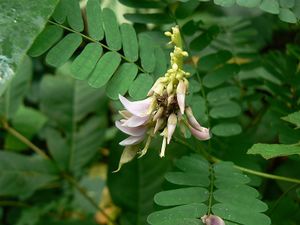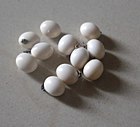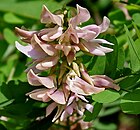Note: This is a project under development. The articles on this wiki are just being initiated and broadly incomplete. You can Help creating new pages.
Abrus precatorius - Gunja
Abrus precatorius is a severely invasive plant in warm temperate to tropical regions, so much so that it has become effectively pantropical in distribution. It had been widely introduced by humans, and the brightly coloured and hard-shelled seeds had been spread by birds.
Uses
Blisters in mouths, mouth sores, bleeding piles, leucorrhoea, Mild diabetes, Cough, physical weakness, ulcer, Urinary trouble, snakebite, infection in intestine.
Parts Used
mature seeds, stem, leaves, Root.
Chemical Composition
Mature seeds contain alkali like abrine, precatorine, etc., abraline; toxalbumin like abrin I, II, III, etc., abrus agglutinin I, II (A. P. A Ⅰ, Ⅱ), sterols like abricin, squnalene, alcohol likeβ-amyrin, cycloartenol, 5β-cholanic acid, abrussic acid, sophoradiol, trimethyltryptophan abrusin galactose, arabinose, xylose, polysaccharide and flavonoids compounds, Seed covers contain gallic acid, abranin), delphinidin.[1]
Common names
| Language | Common name |
|---|---|
| Kannada | Gulaganji |
| Hindi | Gaungchi, Gunchi |
| Malayalam | Kunni, Kunnikkuru |
| Tamil | Gundumani, Kundumani |
| Telugu | Gurivinda or Guriginja |
| Marathi | NA |
| Gujarathi | NA |
| Punjabi | NA |
| Kashmiri | NA |
| Sanskrit | Gunja |
| English | equirity |
Habit
Identification
Leaf
| Kind | Shape | Feature |
|---|---|---|
| Paripinnate | Oblong | Leaf Arrangementis Alternate-spiral |
.[2]
Flower
| Type | Size | Color and composition | Stamen | More information |
|---|---|---|---|---|
| Unisexual | 2-4cm long | pink | Flowering throughout the year and In terminal and/or axillary pseudoracemes |
Fruit
| Type | Size | Mass | Appearance | Seeds | More information |
|---|---|---|---|---|---|
| oblong pod | Thinly septate, pilose, wrinkled | seeds upto 5 | Fruiting throughout the year | {{{6}}} |
Other features
List of Ayurvedic medicine in which the herb is used
- Vishatinduka Taila as root juice extract
Where to get the saplings
Mode of Propagation
How to plant/cultivate
The more common species of Aconitum are generally those cultivated in gardens, especially hybrids. They typically thrive in well-drained evenly moist garden soils like the related hellebores and delphiniums, and can grow in the shade of trees.
Commonly seen growing in areas
Photo Gallery
References
External Links
- Pages that are stubs
- Ayurvedic Herbs known to be helpful to treat Blisters in mouths
- Ayurvedic Herbs known to be helpful to treat mouth sores
- Ayurvedic Herbs known to be helpful to treat bleeding piles
- Ayurvedic Herbs known to be helpful to treat leucorrhoea
- Ayurvedic Herbs known to be helpful to treat Mild diabetes
- Ayurvedic Herbs known to be helpful to treat Cough
- Ayurvedic Herbs known to be helpful to treat physical weakness
- Ayurvedic Herbs known to be helpful to treat ulcer
- Ayurvedic Herbs known to be helpful to treat Urinary trouble
- Ayurvedic Herbs known to be helpful to treat snakebite
- Ayurvedic Herbs known to be helpful to treat infection in intestine
- Herbs with mature seeds used in medicine
- Herbs with stem used in medicine
- Herbs with leaves used in medicine
- Herbs with Root used in medicine
- Herbs with common name in Kannada
- Herbs with common name in Hindi
- Herbs with common name in Malayalam
- Herbs with common name in Tamil
- Herbs with common name in Telugu
- Herbs with common name in Sanskrit
- Herbs with common name in English
- Habit - A small wiry straggler(5m)
- Index of Plants which can be propagated by Seeds
- Herbs that are commonly seen in the region of tropical
- Herbs that are commonly seen in the region of Caribbean Islands
- Herbs that are commonly seen in the region of subtropical
- Herbs that are commonly seen in the region of pinelands
- Herbs that are commonly seen in the region of hammocks
- Herbs






